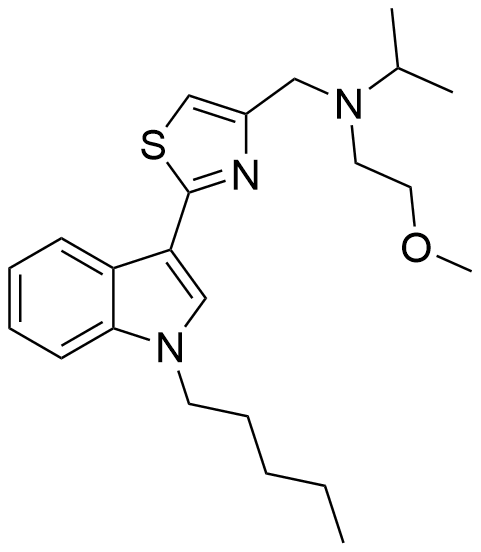Summary
PTI-2 (SGT-49) is a synthetic cannabinoid with an indole-based structure. Notably, it stands out as one of the rare synthetic cannabinoids that incorporates a thiazole group, and it shares a close relationship with PTI-1. These compounds can be considered simplified analogues of the indole-3-heterocycle compounds initially pioneered by Organon and later subjected to extensive research by Merck.
| Identifiers | |
|---|---|
| IUPAC name | |
| CAS Number | 1400742-45-1 |
|---|---|
| ChemSpider | 58827849 |
| UNII | W0MO88040Q |
| Chemical and physical data | |
| Formula | C23H33N3OS |
| Molar mass | 399.60 g·mol−1 |

FAQ
1. What is PTI-2 (SGT-49)?
- PTI-2, also known as SGT-49, is a synthetic cannabinoid with an indole-based structure. It’s notable for containing a thiazole group, differentiating it from other synthetic cannabinoids.
2. How is PTI-2 related to PTI-1?
- PTI-2 is closely related to PTI-1, another synthetic cannabinoid. Both compounds share similarities in their indole-based structures, making them part of the same chemical family.
3. What makes PTI-2 unique among synthetic cannabinoids?
- PTI-2’s uniqueness lies in its incorporation of a thiazole group, a rare feature among synthetic cannabinoids. This structural element sets it apart from many other compounds in this category.
4. What is the history of PTI-2 and its development?
- PTI-2 and its analogues can be traced back to the development of indole-3-heterocycle compounds by Organon. Subsequently, Merck conducted further research into these compounds, leading to the creation of substances like PTI-2.
5. Is PTI-2 safe for consumption or recreational use?
- The safety of PTI-2 for consumption or recreational use is not established. Synthetic cannabinoids can be unpredictable and carry potential health risks. It is essential to exercise caution and adhere to local laws and regulations regarding their use.
6. Where can I find more information about PTI-2?
- Information about PTI-2, its properties, and potential uses can be obtained through scientific literature, research papers, or reputable sources specializing in cannabinoid research. Always ensure you access reliable and up-to-date information.
References
- PTI-2. Cayman Chemical. Retrieved 8 July 2015.
- US Patent 7700634 – Adam-Worrall J, Morrison AJ, Wishart G, Kiyoi T, McArthur DR. Issued 20 April 2010. Title: “(Indol-3-yl) heterocycle derivatives as agonists of the cannabinoid CB1 receptor.” Assigned to Organon NV.
- US Patent 7763732 – Paul David Ratcliffe PD, Adam-Worrall J, Morrison AJ, Francis SJ, Kiyoi T. Issued 27 July 2010. Title: “Indole Derivatives.” Assigned to Organon NV.
- Kiyoi T, Adam JM, Clark JK, Davies K, Easson AM, Edwards D, et al. (March 2011). “Discovery of potent and orally bioavailable heterocycle-based cannabinoid CB1 receptor agonists.” Published in Bioorganic & Medicinal Chemistry Letters, Volume 21 (6), Pages 1748–53. DOI: 10.1016/j.bmcl.2011.01.082. PMID 21316962.